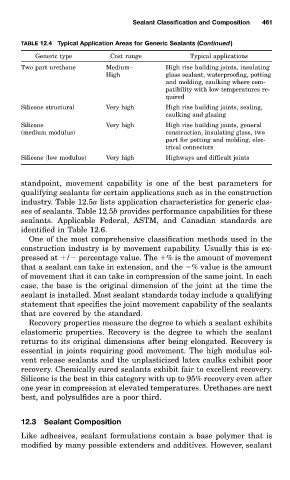Page 534 - Handbook of Adhesives and Sealants
P. 534
Sealant Classification and Composition 461
TABLE 12.4 Typical Application Areas for Generic Sealants (Continued)
Generic type Cost range Typical applications
Two part urethane Medium– High rise building joints, insulating
High glass sealant, waterproofing, potting
and molding, caulking where com-
patibility with low temperatures re-
quired
Silicone structural Very high High rise building joints, sealing,
caulking and glazing
Silicone Very high High rise building joints, general
(medium modulus) construction, insulating glass, two
part for potting and molding, elec-
trical connectors
Silicone (low modulus) Very high Highways and difficult joints
standpoint, movement capability is one of the best parameters for
qualifying sealants for certain applications such as in the construction
industry. Table 12.5a lists application characteristics for generic clas-
ses of sealants. Table 12.5b provides performance capabilities for these
sealants. Applicable Federal, ASTM, and Canadian standards are
identified in Table 12.6.
One of the most comprehensive classification methods used in the
construction industry is by movement capability. Usually this is ex-
pressed at / percentage value. The % is the amount of movement
that a sealant can take in extension, and the % value is the amount
of movement that it can take in compression of the same joint. In each
case, the base is the original dimension of the joint at the time the
sealant is installed. Most sealant standards today include a qualifying
statement that specifies the joint movement capability of the sealants
that are covered by the standard.
Recovery properties measure the degree to which a sealant exhibits
elastomeric properties. Recovery is the degree to which the sealant
returns to its original dimensions after being elongated. Recovery is
essential in joints requiring good movement. The high modulus sol-
vent release sealants and the unplasticized latex caulks exhibit poor
recovery. Chemically cured sealants exhibit fair to excellent recovery.
Silicone is the best in this category with up to 95% recovery even after
one year in compression at elevated temperatures. Urethanes are next
best, and polysulfides are a poor third.
12.3 Sealant Composition
Like adhesives, sealant formulations contain a base polymer that is
modified by many possible extenders and additives. However, sealant

